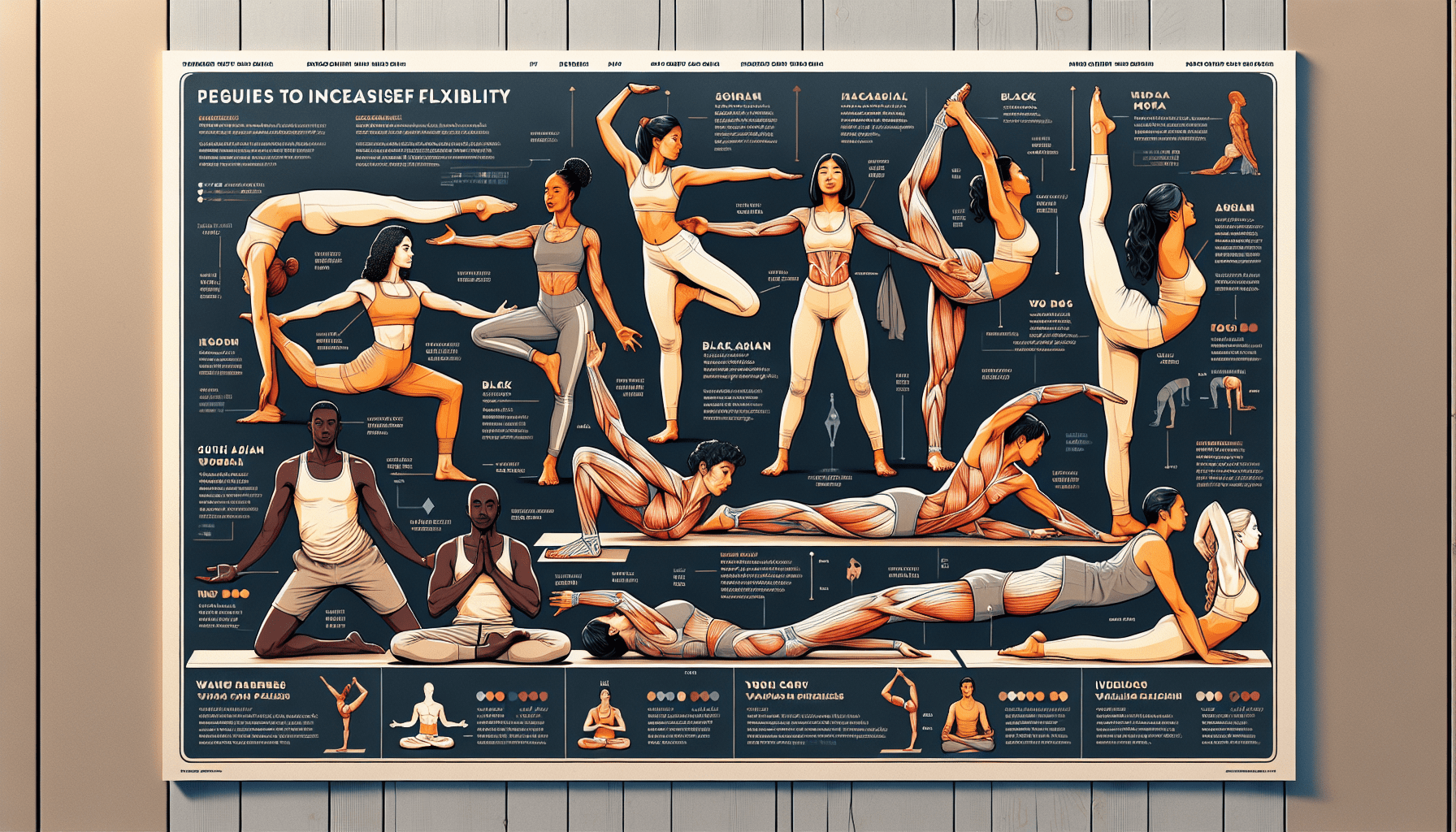Are you looking for an effective and enjoyable way to shed those extra pounds? Look no further than “Yoga for Weight Loss Beginners.” This article will guide you through the wonderful world of yoga, providing you with the tools and techniques needed to kickstart your weight loss journey. Whether you are a complete beginner or have dabbled in yoga before, this article offers a friendly and accessible approach to help you achieve your weight loss goals. So grab your yoga mat and get ready to embark on a transformative journey towards a healthier, happier you.
Benefits of Yoga for Weight Loss
Improves flexibility
One of the key benefits of practicing yoga for weight loss is the improvement in flexibility. As you engage in various yoga poses and stretches, you gradually increase your flexibility and loosen tight muscles. This not only helps in preventing injuries but also allows you to perform other exercises with ease. As your muscles become more flexible, you’ll find it easier to move and burn calories efficiently during your yoga sessions, which contributes to weight loss.
Increases muscle strength
Yoga is not just about relaxation and stretches, it also builds muscle strength. Holding challenging poses and performing sequences that require balance and stability strengthen your muscles and improve overall body strength. The more muscle mass you have, the more calories you burn, even at rest. Regular practice of yoga not only tones your muscles but also helps in boosting your metabolism, leading to weight loss.
Enhances metabolism
Yoga can have a positive impact on your metabolism, which plays a crucial role in weight loss. Certain yoga poses and sequences stimulate the endocrine system, particularly the thyroid gland, which regulates metabolism. By practicing yoga regularly, you can help normalize your metabolic rate, allowing your body to efficiently process food and burn calories. Increased metabolism aids in weight loss, making yoga an effective tool for achieving your weight loss goals.
Boosts energy levels
When you embark on a weight loss journey, maintaining energy levels is crucial. Yoga helps in boosting energy levels by increasing blood circulation and oxygenation throughout the body. The deep breathing techniques used in yoga increase the capacity of your lungs, enhancing oxygen intake and improving energy levels. Additionally, yoga practice promotes relaxation and reduces stress, which can often zap your energy. By incorporating yoga into your routine, you’ll experience an energy boost that can support you in your weight loss efforts.
Promotes mindfulness and self-awareness
Yoga is not just a physical practice; it also focuses on the mind-body connection. By incorporating mindfulness into your yoga practice, you become more present and aware of your body. This awareness extends to your eating habits, promoting mindful eating. In the context of weight loss, mindfulness helps in recognizing and understanding your body’s hunger and satiety cues, allowing you to make informed choices around food. The practice of yoga enhances your self-awareness, helping you build a healthier relationship with food and make conscious decisions for weight loss.
Choosing the Right Yoga Style
Hatha Yoga
Hatha yoga is a gentle and foundational yoga style, making it a great choice for beginners. It focuses on slow-paced movements and foundational poses, allowing you to build a strong yoga practice from the ground up. Hatha yoga incorporates a balance of strength and flexibility, making it suitable for individuals looking to lose weight and improve overall fitness.
Vinyasa Yoga
Vinyasa yoga, also known as flow yoga, is a dynamic and fluid style that synchronizes breath with movement. It involves continuous and seamless transitions between poses, providing a cardiovascular workout while strengthening and toning the body. Vinyasa yoga is an excellent choice for weight loss as it elevates the heart rate and promotes calorie burn.
Power Yoga
Power yoga is a more vigorous and physically demanding style of yoga. It combines strength, flexibility, and cardio, making it an effective practice for weight loss. Power yoga incorporates intense movements, challenging poses, and a fast-paced flow, keeping your heart rate elevated and boosting your metabolism.
Ashtanga Yoga
Ashtanga yoga follows a specific sequence of poses, focusing on synchronizing breath with movement. It is a physically demanding and disciplined style of yoga that builds strength, stamina, and flexibility. Ashtanga yoga can be an effective choice for weight loss as it offers a full-body workout and helps in increasing muscle mass.
Bikram Yoga
Bikram yoga, also known as hot yoga, is practiced in a heated room. The high temperature promotes flexibility, detoxification, and calorie burn. Bikram yoga consists of a series of 26 poses and two breathing exercises, providing a challenging and intense workout. While the heat can be challenging, it also helps in increasing your heart rate and metabolism, aiding in weight loss.

Essential Yoga Poses for Weight Loss
Mountain Pose (Tadasana)
Mountain pose may appear simple, but it is the foundation for many other poses. Stand tall with your feet hip-width apart, grounding through all four corners of your feet. Engage your core, lengthen your spine, and relax your shoulders. Mountain pose builds strength in your legs and core while improving posture and balance.
Warrior II Pose (Virabhadrasana II)
Warrior II pose is a powerful standing pose that engages your legs, core, and arms. From a wide-legged stance, turn your right foot out and bend your right knee, ensuring it is stacked directly above your ankle. Stretch your arms out parallel to the floor, gaze over your right fingertips, and sink lower into the pose. Warrior II strengthens your legs and promotes stability, while toning your arms and increasing endurance.
Downward-Facing Dog (Adho Mukha Svanasana)
Downward-Facing Dog is a popular pose that targets multiple muscle groups and stretches the entire body. Start on your hands and knees, tuck your toes, and lift your hips up and back, forming an inverted V shape. Press your heels towards the ground, lengthen your spine, and relax your head and neck. Downward-Facing Dog strengthens your arms, shoulders, and core, while lengthening your hamstrings and calves.
Bridge Pose (Setu Bandhasana)
Bridge pose is a backbend that targets the glutes, hamstrings, and lower back. Lie on your back with your knees bent and feet hip-width apart. Press through your feet and lift your hips off the ground, creating a bridge shape with your body. Engage your glutes and core, and keep your shoulders and neck relaxed. Bridge pose strengthens your lower body and improves spinal mobility.
Plank Pose (Phalakasana)
Plank pose is a core-strengthening pose that engages your entire body. Start in a push-up position with your hands shoulder-width apart and arms straight. Align your shoulders, hips, and heels in a straight line, engage your core, and hold the pose for a set amount of time. Plank pose builds strength in your core, arms, and legs, while improving stability and posture.
Creating a Yoga Routine
Warm-up exercises
Before diving into your yoga routine, it is essential to warm up your body and prepare it for the practice. You can begin with gentle stretches, such as neck rolls, shoulder rolls, wrist stretches, and hip circles. Incorporating sun salutations or cat-cow poses into your warm-up can also help warm up your entire body and increase blood flow.
Yoga sequence for weight loss
To create an effective yoga routine for weight loss, it is important to incorporate a combination of poses that target different muscle groups and provide a cardiovascular challenge. Begin with standing poses like Warrior II, Triangle Pose, and Crescent Lunge to engage your lower body. Move on to core-strengthening poses like Plank, Boat Pose, and Dolphin Pose. Include backbends, such as Bridge Pose and Cobra Pose, to work your glutes and lower back. Finish your sequence with inversions like Shoulder Stand or Legs-Up-The-Wall Pose to promote circulation and relaxation.
Cooldown poses
After completing your yoga sequence, it is crucial to cool down and stretch your muscles to prevent soreness and promote recovery. Incorporate gentle stretches, such as seated forward folds, spinal twists, and child’s pose. Spend a few moments in Savasana, or Corpse Pose, to allow your body and mind to fully relax and absorb the benefits of your practice.
Breathing exercises
Integrating breathing exercises, such as deep belly breathing or alternate nostril breathing, into your yoga routine can further enhance weight loss. Deep breathing techniques help activate the parasympathetic nervous system, reducing stress and cortisol levels in the body. Stress and high cortisol levels can contribute to weight gain, so by incorporating breathwork, you can support your weight loss journey.

Yoga Equipment for Beginners
Yoga mat
A yoga mat is an essential piece of equipment for any yogi, especially beginners. It provides cushioning and grip, ensuring stability and comfort during your practice. Invest in a high-quality, non-slip yoga mat that suits your needs and preferences.
Yoga blocks
Yoga blocks are useful props that assist in achieving proper alignment and provide support in challenging poses. They can help beginners maintain balance, deepen stretches, and modify poses to accommodate their individual flexibility. Yoga blocks come in various sizes and materials, so choose one that suits your comfort and level.
Yoga strap
A yoga strap is a flexible prop that can be used to extend your reach and deepen stretches. It is particularly useful for beginners who may have limited flexibility. Yoga straps are adjustable and can be looped around different parts of the body to facilitate proper alignment and enhance the benefits of your practice.
Yoga bolster
A yoga bolster is a long, firm cushion that provides support and comfort during restorative poses and meditation. It helps in maintaining proper alignment and relaxation while holding poses for an extended period. A yoga bolster can enhance your yoga practice by allowing you to deepen your stretches and find a more comfortable position.
Yoga blanket
A yoga blanket is a versatile prop that can be used for support, cushioning, and warmth during your practice. It can be folded or rolled up to provide additional height or support in seated poses or to protect your knees and joints in kneeling positions. Yoga blankets also come in handy during relaxation and meditation practices to keep you warm and cozy.
Common Mistakes to Avoid
Overexertion and pushing too hard
One of the most common mistakes beginners make in their yoga practice is pushing themselves too hard and overexerting their bodies. It’s important to listen to your body and honor its limitations. Pushing too hard can lead to injuries and setbacks in your weight loss journey. Remember, yoga is about finding balance and mindfulness, so take it slow and respect your body’s boundaries.
Improper alignment in poses
Proper alignment is vital in yoga to avoid strain, injuries, and imbalance. Beginners often find it challenging to get the alignment right in certain poses. It is crucial to learn the correct alignment from a qualified instructor or through instructional resources. Focus on understanding the alignment cues, engaging the correct muscles, and maintaining a balanced posture in each pose.
Not listening to your body
One of the fundamental principles of yoga is listening to your body and honoring its needs. Beginners may push through discomfort or pain, ignoring the signals their bodies are sending them. It is important to be attentive to sensations and adjust or modify poses accordingly. If a pose doesn’t feel right for you, trust your instincts and opt for a variation that is more suitable for your body.
Skipping warm-up and cooldown
Warm-up and cooldown are essential parts of any exercise routine, including yoga. Failing to warm up properly can lead to muscle strain and injury. Similarly, skipping the cooldown deprives your body of the opportunity to gradually transition out of the practice and relax. Make sure to allocate time for both warm-up exercises and cooldown poses to ensure a safe and effective practice.
Neglecting proper breathing techniques
Breath is the foundation of yoga, and neglecting proper breathing techniques can hinder your progress and experience. Pay attention to the breath cues provided during yoga practice and learn to synchronize your breath with your movements. Proper breathing not only complements the poses but also helps in managing stress, improving focus, and increasing energy levels.
Tips for Beginners
Start with shorter sessions
If you’re new to yoga, it’s recommended to start with shorter sessions and gradually increase the duration as your body adapts. Beginning with 15-20 minute practices allows you to build strength, flexibility, and familiarity with the poses. As you become more comfortable, you can gradually extend your practice to 30 minutes or more. Consistency is key, so aim for regular practice rather than long sessions.
Listen to instructional videos or take classes
As a beginner, it can be beneficial to seek guidance from qualified yoga instructors. Instructional videos or attending yoga classes provide demonstrations, detailed instructions, and modifications for each pose. This can help you understand proper alignment, breathing techniques, and the flow of a well-rounded yoga practice. Choose instructors or videos that resonate with you and align with your goals.
Modify poses as needed
Every body is different, and it is essential to honor your body’s unique needs and limitations. Don’t be afraid to modify poses to suit your comfort level and avoid straining yourself. Using props like blocks, straps, or bolsters can assist in achieving proper alignment and support your practice. Remember, yoga is not a competition, so focus on your own journey rather than comparing yourself to others.
Be patient and consistent
Yoga is a journey that requires patience and consistency. It takes time to build strength, flexibility, and mindfulness. Embrace the process and celebrate small victories along the way. Results may not happen overnight, but with dedication and regular practice, you will gradually notice improvements in your physical and mental well-being.
Gradually increase the intensity
As your fitness level improves, you can gradually increase the intensity of your yoga practice. Explore more challenging poses, sequences, or styles of yoga that offer a higher level of physical exertion. Increase the duration of your practice or combine yoga with other exercises to enhance your weight loss efforts. However, always remember to listen to your body and avoid pushing beyond your limits.
Combining Yoga with Other Exercises
Cardiovascular exercises
While yoga provides numerous benefits for weight loss, combining it with cardiovascular exercises can further accelerate the calorie burn and promote overall fitness. Engaging in activities like running, cycling, swimming, or dancing alongside your yoga practice helps elevate your heart rate, increase endurance, and burn additional calories. Aim for at least 150 minutes of moderate-intensity cardio exercise per week for optimal weight loss results.
Strength training
While yoga does build muscle strength, incorporating specific strength training exercises can further enhance your weight loss efforts. Including exercises like weightlifting, bodyweight exercises, or resistance training in your routine helps increase muscle mass, boost metabolism, and improve body composition. Strength training also provides long-term benefits by increasing bone density and overall functional fitness.
Interval training
Interval training, also known as high-intensity interval training (HIIT), involves alternating between intense bursts of exercise and short recovery periods. This type of training has been proven to be effective for weight loss and improvement in cardiovascular fitness. Consider adding HIIT workouts to your routine a few times a week, either on their own or in combination with yoga sessions.
Pilates
Pilates and yoga share similarities in terms of mindfulness, core strengthening, and flexibility. Adding Pilates exercises to your routine can help strengthen your core muscles, improve posture, and enhance body awareness. By combining yoga and Pilates, you create a well-rounded workout that targets various muscle groups and supports weight loss.
Dance workouts
If traditional cardio exercises don’t appeal to you, incorporating dance workouts into your routine can be a fun and effective way to burn calories and lose weight. Dance workouts, such as Zumba or hip-hop dance classes, combine cardiovascular exercise with rhythmic movements, making them enjoyable and energizing. Dancing improves coordination, elevates mood, and contributes to an overall active lifestyle.
Healthy Eating Habits
Balanced diet with whole foods
A balanced diet rich in nutritious whole foods is essential for supporting weight loss alongside your yoga practice. Focus on consuming a variety of fruits, vegetables, lean proteins, whole grains, and healthy fats. Include colorful produce for vitamins and antioxidants, and choose lean protein sources like chicken, fish, tofu, or legumes. Incorporate whole grains such as quinoa, brown rice, and whole wheat bread to provide sustained energy.
Portion control
Portion control is crucial when it comes to weight loss. Even with healthy foods, overeating can hinder progress. Practice mindful eating by paying attention to your hunger and fullness cues. Use smaller plates and bowls to help control portion sizes, and avoid eating until you feel overly full. Aim for balanced meals that include a mix of protein, carbohydrates, and fats to keep you satisfied and nourished.
Avoiding processed foods
Processed foods, such as sugary snacks, fast food, and pre-packaged meals, are often high in calories, unhealthy fats, and added sugars. These foods can sabotage your weight loss efforts and negatively impact your overall health. Aim to minimize your intake of processed foods and focus on whole, nutrient-dense options. Opt for fresh ingredients, cook meals at home, and choose food options with minimal additives and preservatives.
Mindful eating
Practicing mindful eating goes hand in hand with yoga. Be present and fully engaged with the process of eating. Slow down, savor each bite, and listen to your body’s hunger and fullness sensations. Avoid distractions while eating, such as phones or screens, as they can lead to mindless overeating. By being mindful, you can develop a healthier relationship with food and make conscious choices that align with your weight loss goals.
Staying hydrated
Water plays a vital role in weight loss and overall health. Staying hydrated helps maintain proper bodily functions and supports metabolism. Make it a habit to drink an adequate amount of water throughout the day, especially during and after your yoga sessions. Carry a reusable water bottle with you to ensure you have access to water at all times. Aim to drink at least 8 glasses (64 ounces) of water per day, or more depending on your activity level and climate.
Tracking Progress and Staying Motivated
Taking measurements and before/after photos
Tracking your progress is a great way to stay motivated and celebrate your achievements along the way. Take measurements of your body, such as waist, hips, and thighs, before you start your yoga journey. Additionally, capturing before and after photos allows you to visually see the changes in your body shape and posture. These tangible reminders of your progress can boost your confidence and encourage you to keep going.
Setting realistic goals
Setting realistic and achievable goals is crucial for maintaining motivation and sustaining long-term weight loss. Rather than focusing solely on the number on the scale, set goals related to your yoga practice, such as mastering specific poses, increasing your practice duration, or improving your flexibility. By setting goals that align with your personal journey, you create a positive mindset and enjoy the journey of self-improvement.
Joining a yoga community
Finding a supportive yoga community can provide a sense of belonging and accountability. Consider joining yoga classes, workshops, or online communities where you can connect with like-minded individuals. Engaging with others who share similar goals and challenges can provide inspiration, encouragement, and valuable tips. A supportive community can help you stay motivated on your weight loss journey.
Rewarding yourself
Don’t forget to reward yourself for your hard work and achievements. Treat yourself to small rewards along the way to celebrate milestones or goals reached. Rewards can be non-food related, such as buying new yoga clothes, treating yourself to a relaxing massage, or indulging in a hobby or activity you enjoy. Celebrating your progress reinforces positive habits and motivates you to continue on your weight loss journey.
Celebrating small achievements
Alongside rewarding yourself, take time to acknowledge and celebrate the small achievements you achieve throughout your weight loss journey. Whether it’s holding a challenging pose for a longer duration, completing a challenging yoga sequence, or noticing increased strength and flexibility, celebrate these accomplishments. By focusing on the small wins, you build confidence, momentum, and a positive mindset that fuels your motivation.




